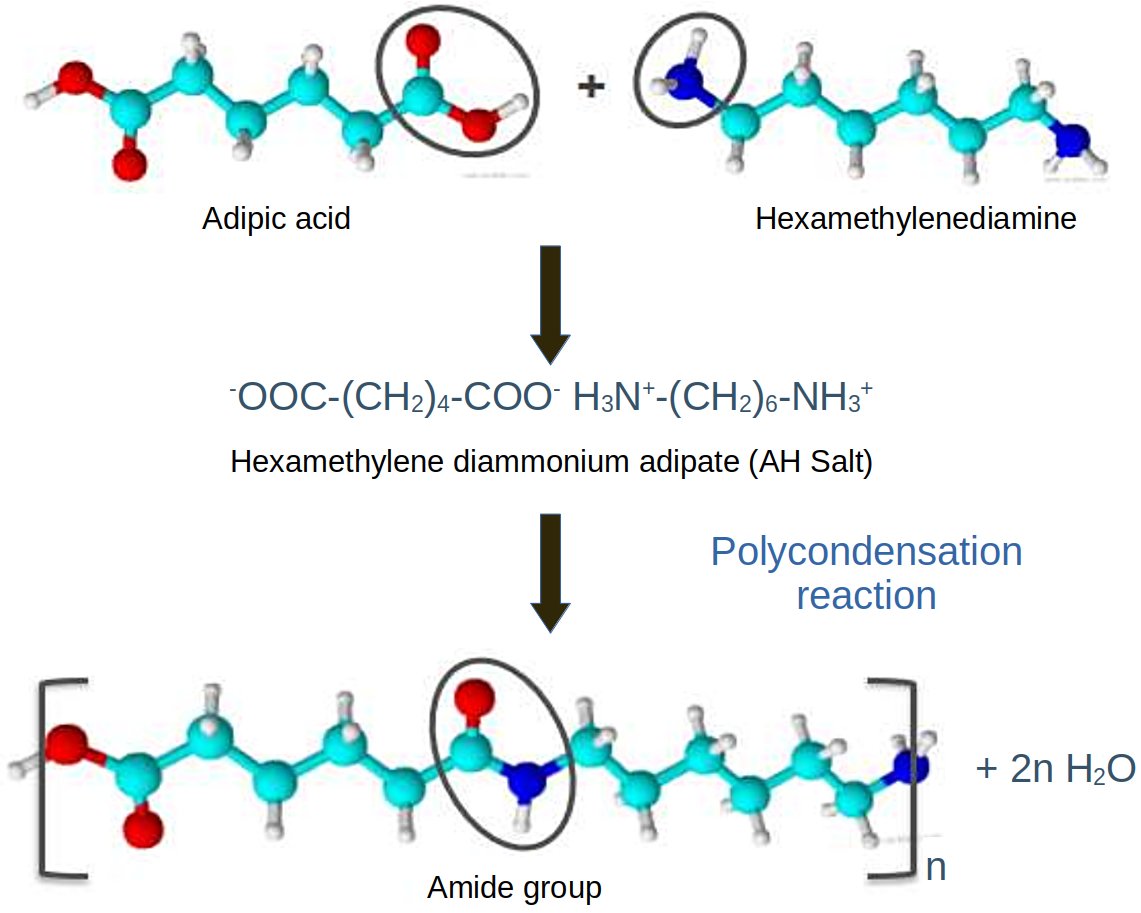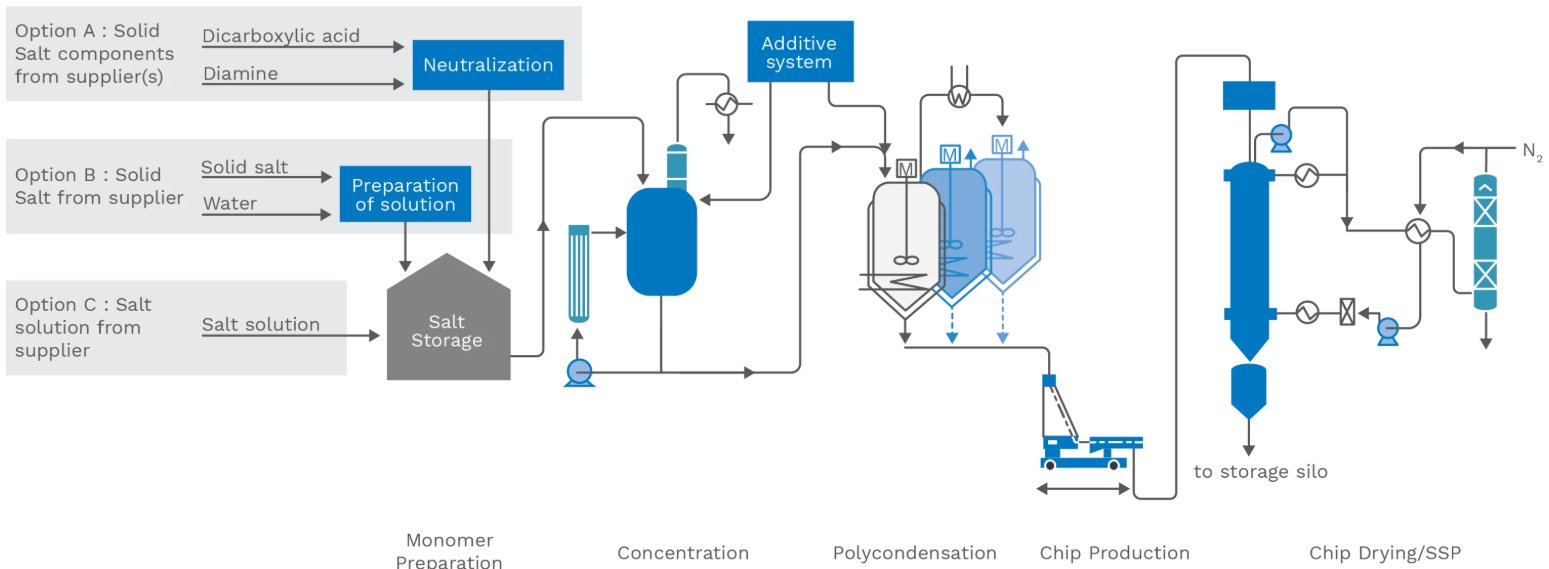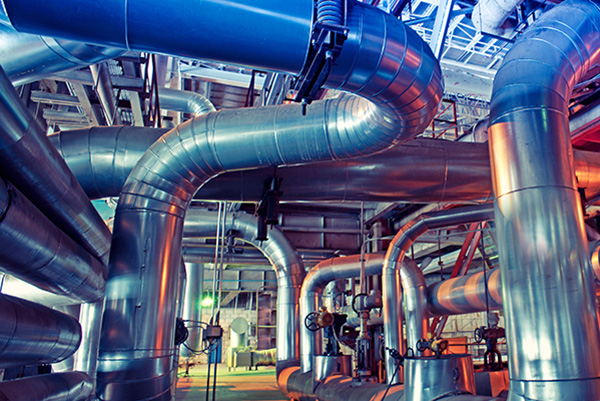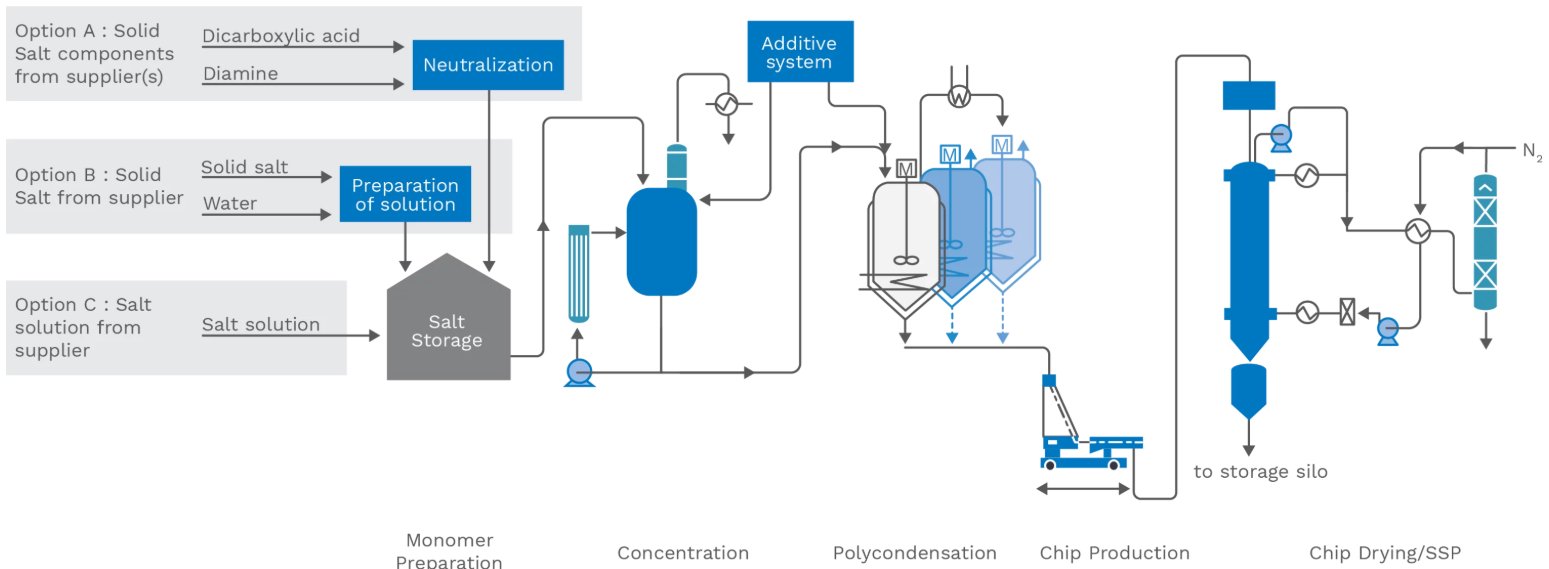Process History
Polyamide 6,6 (nylon 6,6) was first synthesized in the 1930s by Wallace Carothers at DuPont, leading to the first commercial production in 1939 in Seaford, Delaware. This innovation marked the beginning of large-scale synthetic fiber manufacturing and set the foundation for modern engineering plastics[1][2][3]. The process has since been refined for greater efficiency, product quality, and environmental performance[1].
Process Summary and Chemistry
Monomers:
Reaction:
A step-growth polycondensation (often called polyaddition in industry) between equimolar amounts of HMDA and adipic acid via the intermediate AH Salt forms polyamide 6,6 and water as a by-product (Fig. 1)[1][2][3].
Figure 1 - Polyamide 6,6 synthesis from adipic acid and hexamethylenediamine via AH Salt intermediate and polycondensation reaction (adapted from Peduto[1])

Overall Reaction:
n H2N−(CH2)6−NH2 + n HOOC−(CH2)4−COOH → [−NH−(CH2)6−NHCO−(CH2)4−CO−]n + 2n H2O
This reaction forms a linear polyamide with repeating amide linkages, giving nylon 6,6 its characteristic strength and thermal resistance[1][2].
Detailed Process Description
Process Flow Steps
Salt Formation (Nylon Salt Preparation)
- Aqueous solutions of HMDA and adipic acid are mixed in a 1:1 molar ratio to form hexamethylenediammonium adipate (nylon salt).
- Typical concentration: 50–60% nylon salt in water.
- Temperature: 25–60°C[1][3].
- Concentration and Pre-Polymerization
- The nylon salt solution is concentrated by evaporation to ~80% solids.
- The concentrated solution is transferred to a pre-polymerizer (continuous evaporator or autoclave).
- Temperature: 100–150°C; Pressure: slightly above atmospheric[1][3].
- Polycondensation
- The concentrated nylon salt is fed to a high-pressure polymerization reactor.
- Typical conditions:
- Temperature: 270–285°C
- Pressure: 18–25 bar
- Residence time: 4–8 hours (continuous or batch)
- Water generated is removed as steam, driving the reaction to high conversion[1][2][3].
- Finishing and Pelletizing
- The molten polymer is extruded, quenched, and pelletized.
- Optional solid-state polymerization may be used to further increase molecular weight[1][3].
Process Flow Diagram
Figure 2 - Typical set-up of batch plant showing the PA6.6 process[4][5].

To produce the nylon polyamide 6,6 an AH-Salt solution is either created from the monomers adipic acid and hexamethylenediamine (HMD) or by dissolving solid AH-Salt with water. This nylon salt solution is added to the concentration unit where water is evaporated to increase the salt concentration It is then transferred to the autoclave where the polycondensation reaction takes place. Additives can be blended to the concentration unit and polycondensation unit. Multiple autoclaves in parallel ensure a continuous solid state polycondensation (SSP) after chip production[5].
Key Reaction Parameters
| Step |
Temperature (°C) |
Pressure (bar) |
Notes |
| Salt formation |
25–60 |
1 |
Aqueous, stoichiometric mixing |
| Concentration |
100–150 |
1–2 |
Evaporation to ~80% solids |
| Polycondensation |
270–285 |
18–25 |
High-pressure, removal of water |
| Finishing |
80–120 |
1 |
Extrusion, pelletizing |
Process Efficiency and Energy Aspects
- Conversion: Modern plants achieve >99% monomer conversion.
- Yield: High, with minimal by-product formation.
- Energy Use: Major energy input is for heating and pressurizing the polymerization reactor and for evaporating water. Steam generated is often used for process heating elsewhere in the plant.
- Water Management: Efficient removal and reuse of process water is critical for both energy and environmental performance[1][6].
Market Figures
- Global Capacity: In 2024, global polyamide 6,6 capacity was about 4.5–5 million metric tons per year[7][8].
- Major Producers: INVISTA, BASF, Ascend Performance Materials, Radici Group, DOMO Chemicals, Ube Industries[7][8][9].
- Applications: Automotive, textiles, industrial yarns, electrical/electronic components[1][7][9].
Process Technologies and Licensors
| Company / Licensor |
HQ |
Technology
/Brand(s) |
Global Footprint & Notes |
| INVISTA |
USA |
Proprietary |
Largest global PA 6,6 producer; fully integrated; plants in US, Europe, China; advanced ADN technology. |
| BASF |
Germany |
Ultramid® |
Major European producer; integrated value chain; plants in Europe, Asia, Americas. |
| Ascend Performance Materials |
USA |
Proprietary |
Vertically integrated; major US producer; focus on high-performance PA 6,6. |
UBE
Corporation |
Japan |
Proprietary |
Leading Japanese licensor; plants in Japan, Asia, Europe; licenses technology globally. |
DOMO
Chemicals |
Belgium |
TECHNYL® (PA 6,6) |
Vertically integrated; major European producer; expanded with new PA 6,6 plant in Haiyan, China |
Radici
Group |
Italy |
Radipol® |
Vertically integrated; PA 6,6 production in Italy (Novara), Germany (Zeitz), and global compounding |
Toray
Industries |
Japan |
Proprietary |
Major Asian producer; global presence; focus on high-performance PA 6,6 and recycling |
Most major producers operate proprietary, integrated processes and do not widely license technology. Some Japanese and Chinese companies offer licensing for specific process steps[1][7][9].
References
- N. Peduto, 16th May 2024, Polyamides: Synthesis and Properties, Polymer Additives Academy, 2nd Edition, May-June 2024.
- Wikipedia: Nylon 66.
- Mufaddal Bagwala, 12th April 2012, Preparation, Properties and Applications of Nylon 6,6 Fibres, Department of Textile Technology, Shri Vaishnav Institute of Technology and Science, Indore.
- Polyamide 6.6 Technology - Zimmer Polymer Technologies
- 2023, Technip Energies PA66 Flysheet - Zimmer Polymer Technologies.
- David Wallace Jacobson, 3rd May 2017, An industrial process for the production of nylon 6 6 through the step-growth polycondensation of hexamethylenediamine and adipic acid, University of Arkansas.
- Nylon-6 & Nylon-66 Market Outlook - Supply & Demand Analysis 2025-2034, Last Updated: 16th Jan 2025, Expert Market Research (EMR).
- Decode the Future of Polyamide 6,6, Last Updated: Jun 2025, ChemAnalyst.
- Nylon 66 Market Demand Size, Share, Demand, Forecast 2032, Feb 2024, Zion Market Research












